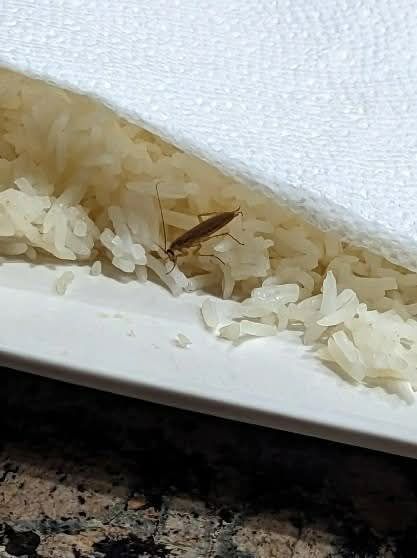ADVERTISEMENT
1. Rice Weevils or Pantry Bugs While this might sound a little unsettling, it’s actually more common than you might think to find tiny pests like rice weevils in stored grains. Rice weevils are small, reddish-brown insects that infest dried foods, particularly rice, flour, pasta, and other pantry staples. These pests typically lay eggs in the food before you buy it, and the larvae hatch inside the packaging.
If you find small, moving specks in your rice, this could very well be the culprit. While the thought of eating rice weevils can be off-putting, it’s important to note that they are harmless and unlikely to cause any harm if consumed. Still, most people prefer to avoid eating them.
How to Prevent It:
- Always store rice and other dry goods in airtight containers to prevent infestations.
- Consider freezing rice for a few days before storing it long-term to kill any potential pests.
- Regularly check your pantry and discard any items with signs of contamination.
2. Rice Husk Fragments Another possibility is that what your kids found were rice husk fragments. These are the protective outer shells of rice grains that sometimes remain after milling. They are generally harmless, but they’re not something you want to find in your cooked rice.
How to Prevent It:
- Rinse your rice thoroughly before cooking it. This helps remove any leftover husk fragments, dirt, or dust.
- Purchase rice from a reputable source to ensure it has been processed and cleaned properly.
3. Foreign Objects from Packaging Sometimes, packaging materials—such as plastic or small paper bits—can get mixed in with rice during the manufacturing process. While it’s rare, you might find a small piece of packaging in your rice. These materials are typically not harmful but should be removed to ensure your rice is safe to eat.
How to Prevent It:
- Always inspect rice packaging before purchasing it to make sure it’s intact and free of holes or damage.
- Before cooking, check the rice thoroughly for any odd objects.
4. Clumps of Rice That Didn’t Cook Right In some cases, what your kids found in the rice could simply be a clump of rice that didn’t fully cook. This can happen if the rice-to-water ratio is off, or the rice wasn’t stirred enough during cooking. These clumps might look unusual but are usually just uncooked rice that hasn’t absorbed water properly.
How to Prevent It:
- Follow the correct cooking instructions for the type of rice you’re using.
- Use a fork to fluff the rice after cooking to separate any clumps and ensure it cooks evenly.
What Should You Do If You Find Something Strange in Your Food?
1. Don’t Panic First and foremost, try not to panic! Most of the time, the strange object you’ve found is not harmful, even if it’s unexpected. It’s always a good idea to inspect what’s in your food, but don’t be alarmed until you know what it is.
2. Identify the Object Take a closer look at the mystery item. Is it something organic, like a bug or rice husk? Is it a foreign object from packaging? Identifying the object can help you determine whether it’s safe or needs to be discarded.
3. Discard If Unsure If you can’t identify the object or if it looks like something potentially harmful (like a piece of broken plastic or sharp object), it’s best to discard that batch of rice and cook a new one.
4. Investigate the Source If you suspect a pest infestation, it’s a good idea to inspect your pantry. Make sure all grains are stored properly, and check for any signs of other pests. Consider disposing of any other infested items to prevent future issues.
How to Avoid Future Surprises
1. Store Food Properly To avoid pests or contamination in your grains, always store rice and other pantry staples in sealed, airtight containers. Glass jars, resealable bags, and plastic containers with tight-fitting lids are great options.
2. Buy Quality Products Purchase rice and other dry goods from reputable stores with a high turnover of stock. If you’re buying rice in bulk, inspect the packaging before buying it.
3. Regular Pantry Checks Make it a habit to check your pantry every few months for signs of contamination or pests. Early detection can prevent a bigger issue down the line.
4. Rinse and Inspect Always rinse your rice before cooking to remove any dust, dirt, or tiny debris that might be present. Give it a quick inspection to ensure there are no foreign objects.
Final Thoughts
Finding something unexpected in your rice bowl can certainly be alarming at first, but there’s no need to panic. By understanding the common causes of these mysterious finds and taking steps to prevent them, you can keep your pantry safe and your meals pest-free. Whether it’s a rice weevil, a rice husk, or a small piece of packaging, most of these issues are easy to manage with a little vigilance and care.
So, the next time you find an odd object in your rice, you’ll know exactly what it might be and how to deal with it—no need for fear, just a little extra attention in the kitchen!
